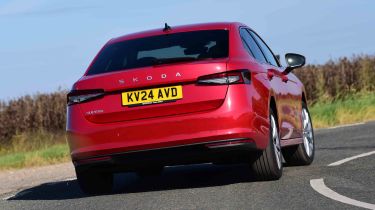Skoda Superb - MPG, CO2 and running costs
The plug-in hybrid Skoda Superb will be the company car choice, while the petrol and diesel models offer excellent efficiency

Both the Skoda Superb hatchback and estate are currently available with mild-hybrid petrol, diesel and a potent pure-petrol engine with four-wheel drive is due soon. The plug-in hybrid powertrain has been reserved for the Superb Estate, which claims to return an almighty 784.3mpg.
Meanwhile, the first-ever mild-hybrid setup in the Superb features a 1.5-litre four-cylinder petrol engine, working together with a starter generator and 48-volt lithium-ion battery that allows the car to coast with the engine completely off, or provides a small boost of power to aid the engine at low speeds. Skoda claims it can return up to 54.1mpg, and during our lengthy test route driving in a more real-world fashion across the Czech countryside and cruising on some motorways saw us achieve 43.5mpg.
The claimed figures for the 2.0-litre four-cylinder diesel engine proved to be even more on the money during our testing, as Skoda claims it will return up to 57.9mpg, and we achieved mid-40mpg overall in real-world driving, with a stretch of motorway driving seeing 60mpg with little effort. Both petrol and diesel models have a 66-litre fuel tank, while the iV plug-in hybrid has a smaller 45-litre tank.
|
Model |
MPG |
CO2 |
Insurance group |
|
Superb 1.5 TSI e-TEC MHEV |
54.1mpg |
120g/km |
24 |
|
Superb 2.0 TSI petrol 4x4 |
35.7mpg |
180g/km |
35 |
|
Superb 2.0 TDI 150 diesel |
57.9mpg |
128g/km |
24 |
|
Superb Estate iV 1.5 PHEV |
784.3mpg |
8g/km |
30 |
Electric range, battery and charging
The plug-in hybrid Skoda Superb Estate iV offers a pure-electric range of 70 miles thanks to a 25.7kWh battery (19.7kWh useable), although we’ll need to drive this version in order to find out how accurate that figure is.
Used - available now

2019 Skoda
Superb
16,132 milesAutomaticPetrol1.5L
Cash £17,506
2018 Skoda
Superb
38,623 milesAutomaticPetrol1.4L
Cash £13,887
2023 Skoda
Superb
84,000 milesManualDiesel2.0L
Cash £13,720
2021 Skoda
Superb
55,672 milesAutomaticDiesel2.0L
Cash £17,600Just like the Volkswagen Passat eHybrid, the Superb iV has a maximum charging speed of 50kW, meaning a 10 to 80 per cent from a DC rapid charger could take just 25 minutes. Alternatively, fully recharging the battery using a common 7kW home wallbox charger requires a little under four hours.
Tax
Company car drivers will be drawn more towards the iV plug-in hybrid versions of the Skoda Superb thanks to much more affordable Benefit-in-Kind (BiK) company car tax rates compared with a petrol or diesel alternative. You could save more money by opting for an electric car like the brand’s similarly practical Skoda Enyaq, though.
The plug-in hybrid would cost you quite a bit in yearly Vehicle Excise Duty (VED) tax because the cheapest version, unfortunately, costs over £40,000 when new. This means you’ll have to pay an additional surcharge from the second time the vehicle is taxed for five years or until it is six years old.
Insurance groups
The Skoda Superb should be less expensive to insure than its Passat sibling, with insurance starting in group 24 and rising to group 35 for the 2.0 TSI 4x4 petrol.
By way of comparison, the VW Passat starts in group 30 before going up to group 40 for the quickest eHybrid 272 plug-in hybrid.
Depreciation
Over a typical three-year/36,000-mile ownership period, our experts predict that the Skoda Superb range should maintain between 46 to 48 per cent of its resale value, with the worst being the top-of-the-range, four-wheel drive 2.0 TDI 193 Laurin & Klement Estate, and the best being the hatch in 2.0 TDI 150 SE Technology form. Those percentage figures are similar to the Volkswagen Passat, which is a fine result considering the Passat is slightly more expensive to begin with.
To get an accurate valuation on a specific model check out our valuation tool...








